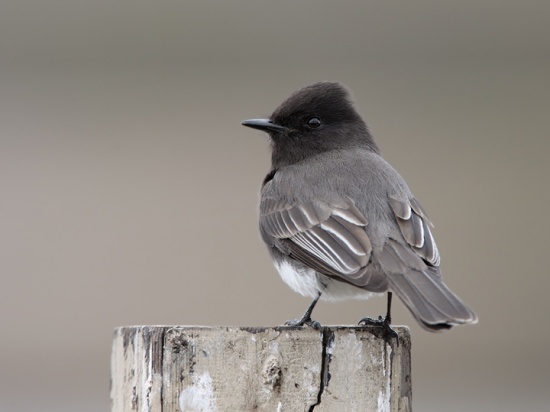- Sayornis nigricans
Identification
15–18 cm (6-7 in)
- Black head, breast, back, wings, and tail
- White underbelly and wing-covert edges (forming 2 faint wing bars)
Distribution
North, Central and South America:
South-western North America: found in (south-western Oregon and California to west Texas).
Central America: (from Panama to Mexico)
Mountainous areas of South America: (Andes of north-western Argentina, western Bolivia, Peru, Ecuador, Colombia and Venezuela; coastal mountains of Venezuela);
Taxonomy
Subspecies
There are 6 subspecies1:
- S. n. amnicola - Highlands of Costa Rica and western Panama (Chiriquí)
- S. n. aquaticus - Southern Mexican highlands (southern Chiapas) to Guatemala and Nicaragua
- S. n. angustirostris - Eastern Panama to Colombia, Ecuador, central Bolivia and northern Venezuela
- S. n. latirostris - Andes of southern Bolivia and north-western Argentina
- S. n. nigricans - Highlands of north-eastern Mexico (Tamaulipas) to northern Chiapas
- S. n. semiater - Western US (Oregon) to Baja California and western Mexico (Nayarit)
Habitat

Photo © by Stanley Jones
Floresville River Park, Floresville, Wilson County, Texas, USA, 19 May 2018
Open woodlands near water, such as streams, rivers, lakes and coastal cliffs.
Behaviour
Action
Like other phoebes, they continually wag their tails when perched.
Diet
They sally from open perches for flying insects. The diet consists insects such as bees, wasps, grasshoppers, moths, caterpillars and beetles. They also reportedly take small fish.
Breeding
The female builds the nest from grass and mud under a wall, bridge or cliff. The 3-6 white eggs are incubated for about 14 days; the young fledge in about another 14 days. Often two broods are raised in a season.
Vocalisation
Song: a series of phrases, rendered sisee and sitsew
Call: similar to that of the Eastern Phoebe.
References
- Clements, J. F., T. S. Schulenberg, M. J. Iliff, S. M. Billerman, T. A. Fredericks, B. L. Sullivan, and C. L. Wood. 2019. The eBird/Clements Checklist of Birds of the World: v2019. Downloaded from http://www.birds.cornell.edu/clementschecklist/download/
- Cornell Lab of Ornithology. 2019. All About Birds. Cornell Lab of Ornithology, Ithaca, New York. https://www.allaboutbirds.org Accessed on 27 April 2020
- Farnsworth, A. & Lebbin, D. (2020). Black Phoebe (Sayornis nigricans). In: del Hoyo, J., Elliott, A., Sargatal, J., Christie, D.A. & de Juana, E. (eds.). Handbook of the Birds of the World Alive. Lynx Edicions, Barcelona. (retrieved from https://www.hbw.com/node/57380 on 27 April 2020).
- Wolf, B. O. (2020). Black Phoebe (Sayornis nigricans), version 1.0. In Birds of the World (A. F. Poole and F. B. Gill, Editors). Cornell Lab of Ornithology, Ithaca, NY, USA. https://doi.org/10.2173/bow.blkpho.01
Recommended Citation
- BirdForum Opus contributors. (2025) Black Phoebe. In: BirdForum, the forum for wild birds and birding. Retrieved 5 January 2025 from https://www.birdforum.net/opus/Black_Phoebe
External Links
GSearch checked for 2020 platform.






